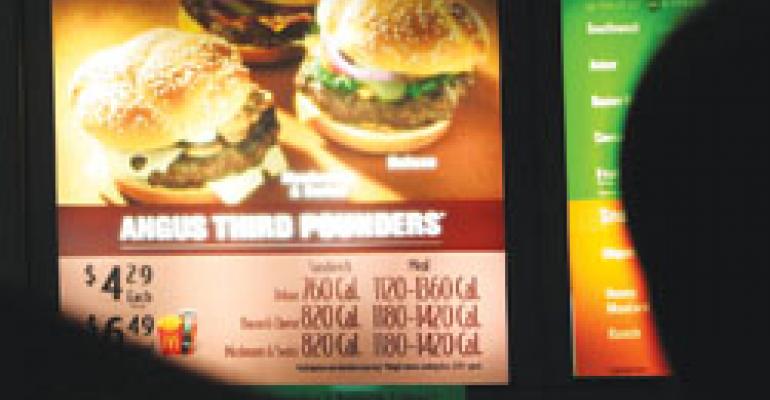As the enforcement deadline loomed for New York City’s menu-labeling mandate, officials of chains already displaying the required calorie data said the disclosures had little effect on ordering habits. But front-of-the-house staff were telling a different story.
While some chains purposely delayed their calorie postings until the July 18 deadline, after which they could face fines of $200 to $2,000 and deductions in health code inspection scores, workers at restaurants that began displaying the information as early as March said newly sensitized customers were demonstrating a newfound caution in their ordering practices.
A cashier at a Starbucks Coffee branch near Carnegie Hall, for example, said management told him sales from the bakery case, which contains some items exceeding 400 calories, had fallen by $1,000 per week after the calorie information was posted. Staff at other Starbucks also linked drops in sales of baked goods and increased interest in lighter beverages to the landmark ordinance.
A host at the T.G.I. Friday’s at 50th Street and Seventh Avenue said customers who had been ordering the same items for five years had started to order lower-calorie dishes once the data were posted. The chain’s Jack Daniel’s Rib & Shrimp, for example, tops out at 1,900 calories.
Jamba Juice workers also said customers had shown a new regard for lower-calorie items, and a Così branch’s barista reported a declining interest in smoothies, which are now labeled as having as many as 1,000 calories.
Still, other compliant chains reported that the impact was minimal or that it was simply too soon to tell.
Chris Arnold, public relations director for Chipotle, one of the few chains that started posting calorie information on the original, unenforced, March 31 deadline, said his chain’s customers haven’t reacted much.
“We haven’t really seen a perceptible change in what customers are doing,” he said. “I think people who go to our restaurants, even without having that calorie information posted, know how to make it work for them.”
Chipotle’s style of assembling guests’ food in front of them according to their instructions works well with the New York City regulations, which allow posting of calorie information in ranges. Guests can have guacamole, sour cream and cheese on their burritos, or not, so their entrées can have anything from 420 calories to 918 calories, according to the menu board.
Arnold says their sales recording data would monitor a change in guacamole purchases, because it costs extra, but not cheese or sour cream, which are complimentary.
Patrick Lenow, director of public relations and communications for DineEquity, parent company of Applebee’s and IHOP, said his company’s restaurant also has posted their calorie information since March and hadn’t noticed a “blip” in what people were ordering.
But a hostess at the Applebee’s near 50th Street and Seventh Avenue, north of Times Square, said her unit only had a few copies of menus with calories on them and didn’t give them to customers unless they asked for them. “And they don’t really ask,” she said.
David Craven, marketing director of Qdoba, which only started posting calorie data on menu boards in recent weeks, says it’s still too early to tell if there has been a change in what people are ordering.
“Sales continue to grow,” he said, “so the labeling has had no negative impact on sales, at least not that we’ve seen. Guests have appreciated the calorie guides we put together, as well as the ‘healthy eating’ special menu we created.”
Qdoba’s Healthy Eating menu highlights items that are low in calories, fat or carbohydrates and includes their nutritional information. The chain’s Calorie Guide brochure lists menu items in their high and low ranges, showing what ingredients would be in a lower-calorie item, and which ones in a higher-calorie one.
For example, the 640-calorie queso burrito would be “naked,” or without a tortilla, and contain rice, pinto beans, chicken and queso sauce. The 1,120-calorie queso burrito would be in a tortilla with rice, black beans, steak, queso sauce, cheese and sour cream.
The calorie-posting rule is an attempt by the New York City Department of Health and Mental Hygiene to try to stem the tide of rising rates of obesity. It requires that chains of 15 or more units display calorie counts on menus and menu boards.
In May, the Los Angeles County public health department said a study it conducted found that if just 10 percent of customers at chain restaurants reduced their calorie consumption by 100 calories per meal, that would avert 38.9 percent of that county’s 6.75 million-pound average annual weight gain.
A 2005 report from the U.S. Department of Agriculture’s Economic Research Service, “Nutrition Labeling in the Food-Away-From-Home Sector: An Economic Assessment” said the likely result of menu labeling would be a change for the better in the nutritional content of menu items—a direction in which many chain restaurants are heading anyway.
But some restaurants, facing an already litigious public, are concerned that, with posted calorie information, a staff member’s heavy hand with sauce could result in a lawsuit.
Last month, Applebee’s, Chili’s, Romano’s Macaroni Grill and On the Border were accused by plaintiffs of offering ostensibly low-calorie items that were in fact much higher in calories than indicated. The New York State Restaurant Association is pursuing a legal challenge to the city’s regulations, and a number of chains were holding off on posting their calorie information until the July 18 deadline.
“We’re planning on doing it on the 18th, which is the last day,” said McDonald’s franchisee Irwin Kruger, whose ISK Manhattan operates five units in the city.
Kruger had expressed concern in the past that posting the additional information on menu boards would slow down service times.
“I think it’s certainly not going to enhance our service times,” he said, “but we expect to adapt to the regulations and deliver our menu items in the same way we have in the past.
“I’m keeping my fingers crossed.”




